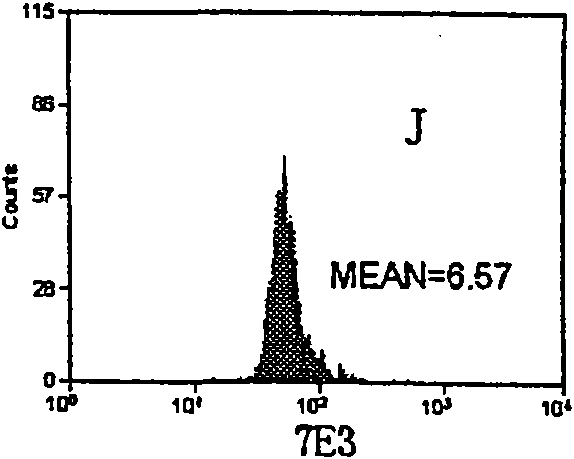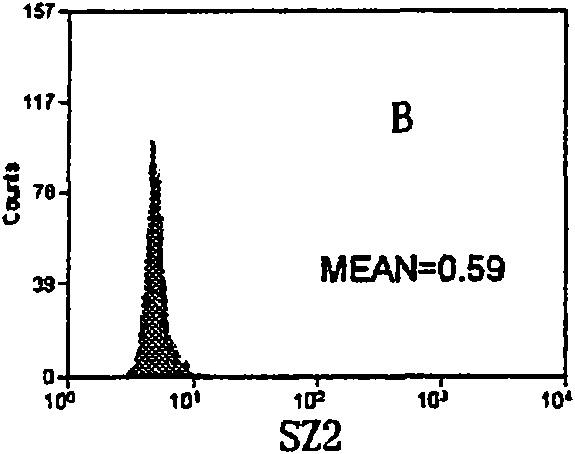Kit for detecting specificity platelet antoantibody by combination of monoclonal antibody and nano-microspheres
A technology of nano-microspheres and autoantibodies, which can be used in measurement devices, instruments, fluorescence/phosphorescence, etc., can solve the problems that cannot be used as a routine inspection for diagnosing ITP, the steps are cumbersome, and the standardization is difficult.
- Summary
- Abstract
- Description
- Claims
- Application Information
AI Technical Summary
Problems solved by technology
Method used
Image
Examples
Embodiment 1
[0033] The preparation of embodiment 1 kit
[0034] 1. Preparation and purification of monoclonal antibodies
[0035] The monoclonal antibodies SZ-2, SZ-21, SZ-22 and 7E3 in this example were self-made by the inventors. Monoclonal antibodies SZ-2, SZ-21, SZ-22 and 7E3 ascites were respectively at pH8.0, 0.1M PB (0.1mol / L Na 2 HPO 4 , 0.1mol / LNaH 2 PO 4, pH8.0)), centrifuge (8000rpm), take about 1ml of the supernatant and pass it through the column (affinity chromatography column ProteinG-Sepharose 4B) to fully bind each monoclonal antibody to protein G, buffer with 0.1M glycine-hydrochloric acid solution (pH2.8) to collect each monoclonal antibody peak. The collected monoclonal antibodies were concentrated with polyethylene glycol 20000, and then dialyzed in 0.01M PBS for 4 hours to obtain pure monoclonal antibodies SZ-2, SZ-21, SZ-22 and 7E3, which were stored in a low-temperature refrigerator for later use .
[0036] 2. Connection of monoclonal antibody to nanospheres...
Embodiment 2
[0044] Example 2 Detection of platelet-specific autoantibodies
[0045] 1. Preparation of platelet lysate
[0046] According to the platelet counts of patients and healthy people, 2ml of peripheral venous blood was collected with EDTA anticoagulated siliconized tubes, mixed gently and then centrifuged at 800rpm for 10min, and the upper layer of platelet-rich plasma was taken, centrifuged at 3000rpm for 10min, and the separated plasma was stored at -20°C (used as MAIPA) ), take the platelet pellet, wash the platelet 3 times with 0.05% EDTA-PBS, count the platelet, adjust the platelet concentration to 1×10 7 per ml, absorb 400 μl, centrifuge at 3000rpm for 5min, discard the supernatant, add 240μl Triton X-100 with a concentration of 0.5% (20min at room temperature), centrifuge at 3000rpm for 5min, draw the supernatant into 4 Eppendorf tubes, 50μl per tube, namely Obtain platelet lysate.
[0047] 2. Detection by flow cytometry
[0048] Pipette 50 μl of monoclonal antibody nano...
Embodiment 3
[0049] Example 3 Detection of the Stability of the Monoclonal Antibody Connected on the Microsphere
[0050] Place the four monoclonal antibody-nanospheres (SZ-2-nanospheres, SZ-22-nanospheres, SZ-21-nanospheres and 7E3-nanospheres) at 4°C for 45 days, every 9 Take 50 μl of monoclonal antibody-nanospheres to react with 10 μl of FITC-GAH-IgG (0.75 mg / ml) every day, and use flow cytometry to detect the average fluorescence intensity of the microspheres, which is used to reflect the stability of the connection between the antibody and the microspheres . The results showed that the amount of antibody on the surface of the detected microspheres changed very little, and the coefficients of variation were 2.15%, 2.65%, 4.22%, and 3.05%, respectively, and they could be stored at 4°C for at least 45 days.
PUM
| Property | Measurement | Unit |
|---|---|---|
| diameter | aaaaa | aaaaa |
Abstract
Description
Claims
Application Information
 Login to View More
Login to View More - R&D Engineer
- R&D Manager
- IP Professional
- Industry Leading Data Capabilities
- Powerful AI technology
- Patent DNA Extraction
Browse by: Latest US Patents, China's latest patents, Technical Efficacy Thesaurus, Application Domain, Technology Topic, Popular Technical Reports.
© 2024 PatSnap. All rights reserved.Legal|Privacy policy|Modern Slavery Act Transparency Statement|Sitemap|About US| Contact US: help@patsnap.com










